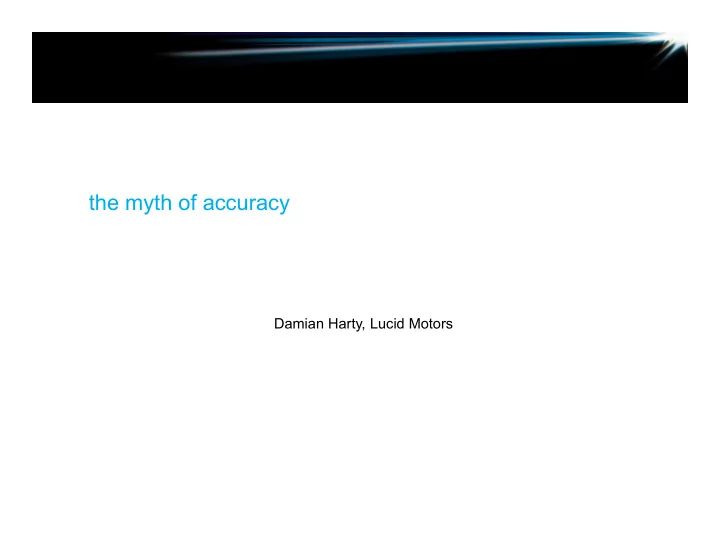

the myth of accuracy Damian Harty, Lucid Motors
the myth of accuracy • It’s easy to believe that the “usefulness” (utility?) of any modelling process is directly related to its accuracy Use Accuracy • This simple misconception can cost money for organisations • Reality is not complex but rather somewhat counter-intuitive! 100 80 Usefulness (%) 60 40 Myth 20 0 0 20 40 60 80 100 Accuracy (%)
the myth of accuracy • What is Accuracy? • “the absence of a numerical difference between predicted and measured behaviour” • not yes/no; absence of accuracy = error • is the measured data what actually happens in the absence of measurement? • is the measured data what actually happens in service? Tay Bridge collapse, 1849. Costing 75 lives, the collapse was subsequently attributed to the absence of cross-wind loads in design calculations.
the myth of accuracy • What is Usefulness? • “the degree to which predictions are able to be used advantageously in the design process” • if predictions are not to be used during the design process their merit should be questioned • if predictions are not timely, they are not useful – however good they are Boeing Dash-80, the prototype 707 airliner, first flew in 1954. It famously performed a roll at the 1955 Seafair Gold Cup. Boeing President William Allen asked a guest with a heart problem to donate some pills, having not been told about the planned stunt beforehand. Orders rolled in and the rest is history.
1 duration Accuracy e the myth of accuracy • How does accuracy relate to usefulness? • Consider the “law of diminishing returns” , which could be represented thus: 1 duration Accuracy e 100 80 Accuracy (%) 60 40 20 0 0 20 40 60 80 100 Duration (%)
1 duration Accuracy e the myth of accuracy • It could be argued that Usefulness is degraded by excessive duration: 1 Use f duration • (the same answer known sooner is more useful) 100 80 Usefulness (%) 60 40 20 0 0 20 40 60 80 100 Duration (%)
1 duration Accuracy e the myth of accuracy • Clearly the accuracy of the answer is of some import • Combining this with the previous description yields: Accuracy Use ( 1 Accuracy ) e • Compare it with the myth: 100 80 Usefulness (%) 60 40 Myth Usefulness 20 0 0 20 40 60 80 100 Accuracy (%)
1 duration Accuracy e the myth of accuracy • Am I advocating 80% error in all calculations? • Er, no • Some level of accuracy is necessary to discern the consequences of the decisions being made; if the method cannot distinguish between alternatives it is inapplicable • Downward convex curve suggests unnecessary accuracy should be studiously avoided • Beware the paralysis of analysis! 100 80 Usefulness (%) 60 40 Myth Usefulness 20 0 0 20 40 60 80 100 Accuracy (%)
1 duration Accuracy e the myth of accuracy • “The most cost effective analysis activity is accurately recalling and comprehending what has gone before” [1] • “All models are wrong, some models are useful” • “Simple models, smartly used” • If I add this to the analysis, what decisions will it change once the results are known? 100 80 Usefulness (%) 60 40 Myth Usefulness 20 0 0 20 40 60 80 100 Accuracy (%) [1] “The Multibody Systems Approach to Vehicle Dynamics”, Blundell & Harty, 2004, Elsevier Science
Recommend
More recommend